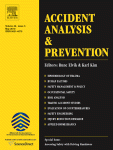This paper presents findings from the rural and remote road safety study, conducted in Queensland, Australia, from March 2004 till June 2007, and compares fatal crashes and non-fatal but serious crashes in respect of their environmental, vehicle and operator factors.
During the study period there were 613 non-fatal crashes resulting in 684 hospitalised casualties and 119 fatal crashes resulting in 130 fatalities. Additional information from police sources was available on 103 fatal and 309 non-fatal serious crashes.
Over three quarters of both fatal and hospitalised casualties were male and the median age in both groups was 34 years.
Fatal crashes were more likely to involve speed, alcohol and violations of road rules and fatal crash victims were 2½ times more likely to be unrestrained inside the vehicle than non-fatal casualties, consistent with current international evidence.
After controlling for human factors, vehicle and road conditions made a minimal contribution to the seriousness of the crash outcome.
Targeted interventions to prevent fatalities on rural and remote roads should focus on reducing speed and drink driving and promoting seatbelt wearing.
Read Full Abstract
Request Reprint E-Mail: v.siskind@qut.edu.au
During the study period there were 613 non-fatal crashes resulting in 684 hospitalised casualties and 119 fatal crashes resulting in 130 fatalities. Additional information from police sources was available on 103 fatal and 309 non-fatal serious crashes.
Over three quarters of both fatal and hospitalised casualties were male and the median age in both groups was 34 years.
Fatal crashes were more likely to involve speed, alcohol and violations of road rules and fatal crash victims were 2½ times more likely to be unrestrained inside the vehicle than non-fatal casualties, consistent with current international evidence.
After controlling for human factors, vehicle and road conditions made a minimal contribution to the seriousness of the crash outcome.
Targeted interventions to prevent fatalities on rural and remote roads should focus on reducing speed and drink driving and promoting seatbelt wearing.
Read Full Abstract
Request Reprint E-Mail: v.siskind@qut.edu.au



























